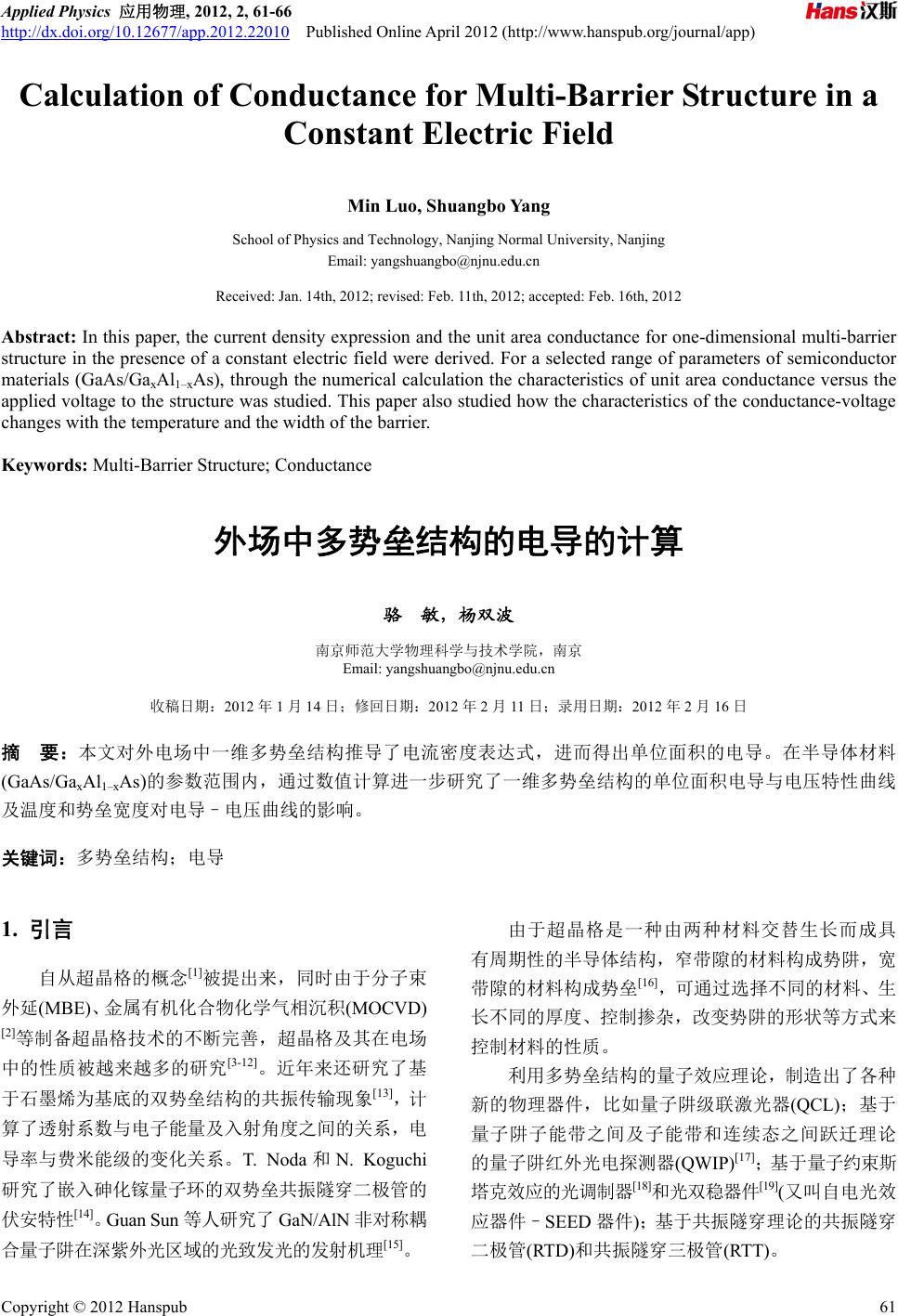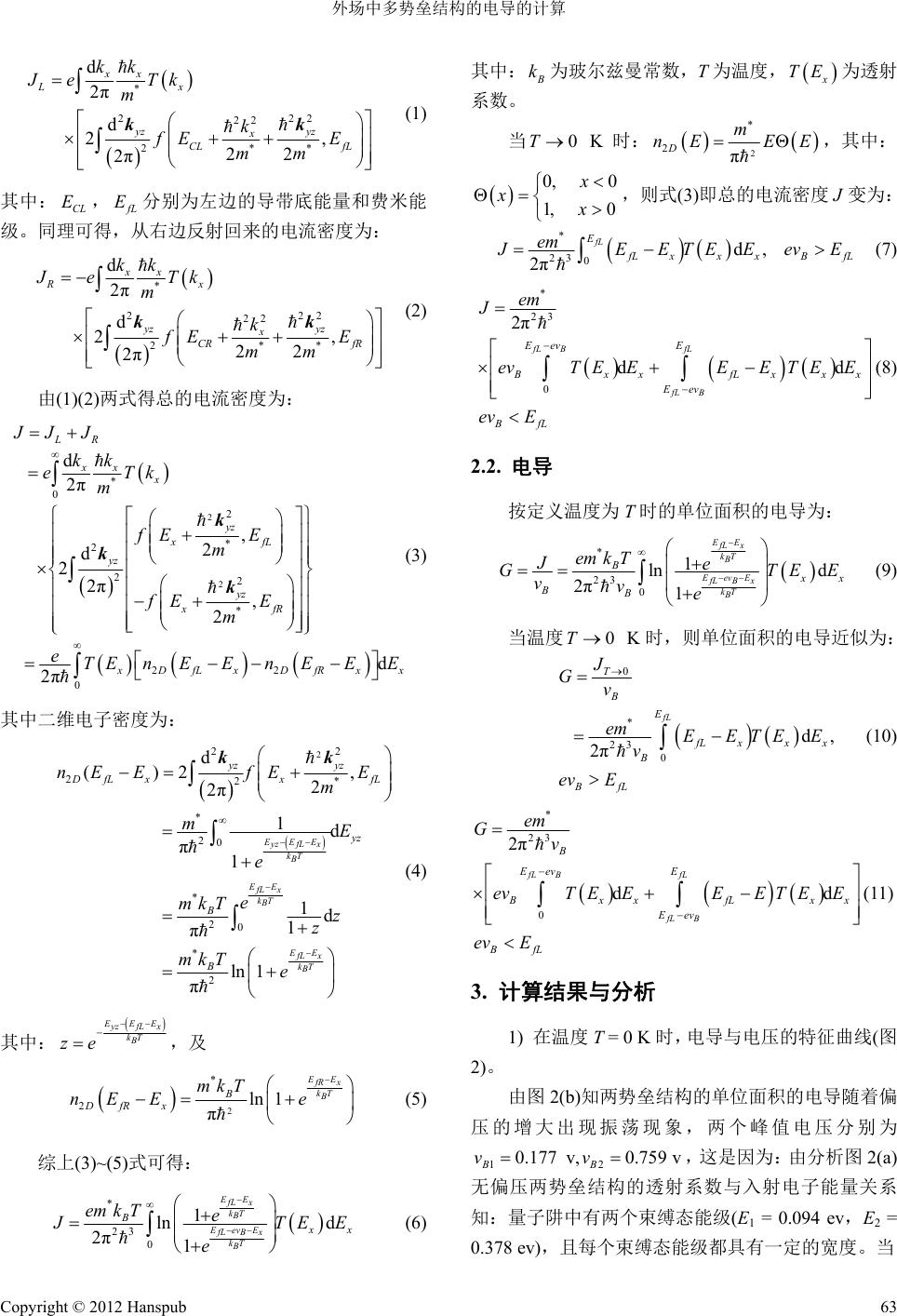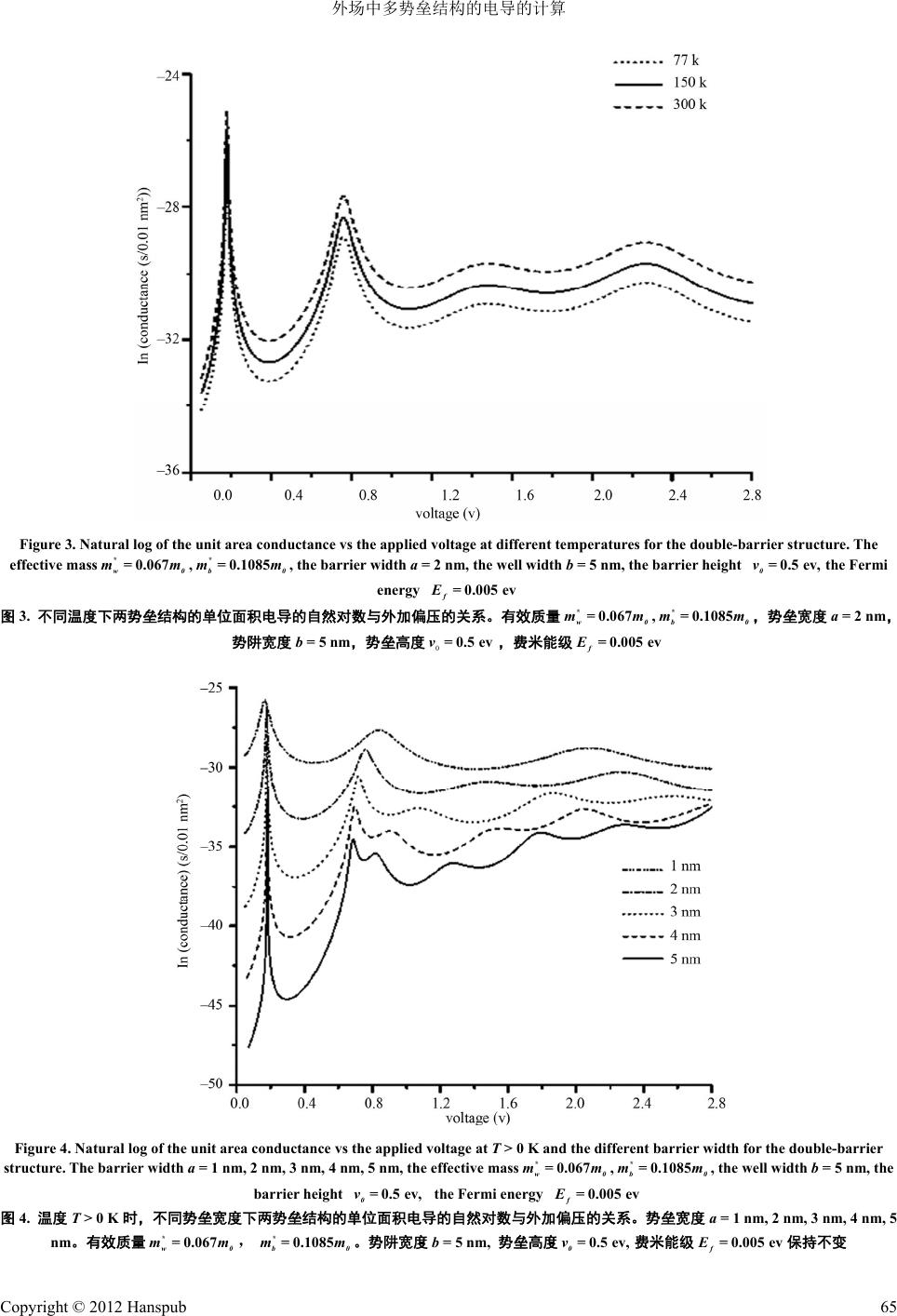 Applied Physics 应用物理, 2012, 2, 61-66 http://dx.doi.org/10.12677/app.2012.22010 Published Online April 2012 (http://www.hanspub.org/journal/app) Calculation of Conductance for Multi-Barrier Structure in a Constant Electric Field Min Luo, Shuangbo Yang School of Physics and Technology, Nanjing Normal University, Nanjing Email: yangshuangbo@njnu.edu.cn Received: Jan. 14th, 2012; revised: Feb. 11th, 2012; accepted: Feb. 16th, 2012 Abstract: In this paper, the current density expression and the unit area conductance for one-dimensional multi-barrier structure in the presence of a constant electric field were derived. For a selected range of parameters of semiconductor materials (GaAs/GaxAl1–xAs), through the numerical calculation the characteristics of unit area conductance versus the applied voltage to the structure was studied. This paper also studied how the characteristics of the conductance-voltage changes with the temperature and the width of the barrier. Keywords: Multi-Barrier Structure; Conductance 外场中多势垒结构的电导的计算 骆 敏,杨双波 南京师范大学物理科学与技术学院,南京 Email: yangshuangbo@njnu.edu.cn 收稿日期:2012 年1月14 日;修回日期:2012年2月11日;录用日期:2012年2月16日 摘 要:本文对外电场中一维多势垒结构推导了电流密度表达式,进而得出单位面积的电导。在半导体材料 (GaAs/GaxAl1–xAs)的参数范围内,通过数值计算进一步研究了一维多势垒结构的单位面积电导与电压特性曲线 及温度和势垒宽度对电导–电压曲线的影响。 关键词:多势垒结构;电导 1. 引言 自从超晶格的概念[1]被提出来,同时由于分子束 外延(MBE)、金属有机化合物化学气相沉积(MOCVD) [2]等制备超晶格技术的不断完善,超晶格及其在电场 中的性质被越来越多的研究[3-12]。近年来还研究了基 于石墨烯为基底的双势垒结构的共振传输现象[13],计 算了透射系数与电子能量及入射角度之间的关系,电 导率与费米能级的变化关系。T. Noda和N. Koguchi 研究了嵌入砷化镓量子环的双势垒共振隧穿二极管的 伏安特性[14]。Guan Sun 等人研究了 GaN/AlN 非对称耦 合量子阱在深紫外光区域的光致发光的发射机理[15]。 由于超晶格是一种由两种材料交替生长而成具 有周期性的半导体结构,窄带隙的材料构成势阱,宽 带隙的材料构成势垒[16],可通过选择不同的材料、生 长不同的厚度、控制掺杂,改变势阱的形状等方式来 控制材料的性质。 利用多势垒结构的量子效应理论,制造出了各种 新的物理器件,比如量子阱级联激光器(QCL);基于 量子阱子能带之间及子能带和连续态之间跃迁理论 的量子阱红外光电探测器(QWIP)[17];基于量子约束斯 塔克效应的光调制器[18]和光双稳器件[19](又叫自电光效 应器件–SEED 器件);基于共振隧穿理论的共振隧穿 二极管(RTD)和共振隧穿三极管(RTT)。 Copyright © 2012 Hanspub 61  外场中多势垒结构的电导的计算 本文通过电子在一定能量和波矢下入射多势垒 结构的透射系数来计算电流密度[20-22],然后进一步推 导出单位面积的电导,研究了电导与电压特性曲线及 温度和势垒宽度对它的影响,其中计算透射系数采用 了转移矩阵方法[23,24]。 2. 模型与理论 本文采用的模型如图1所示,其中,N为势垒的 个数, 为势垒的高度,势垒和势阱中电子的有效质 量分别为 和,势垒和势阱的宽度分别为 , 0 v * b m* w m,ab B v 是对势垒结构所加的外电压。 现考虑将 GaAs/Ga0.5Al0.5As 导带简化成多势垒 结构,GaAs 形成势阱,GaAlAs形成势垒,如图 1(a) 所示,且假定该多势垒结构中势垒和势阱不含杂质, 对该势垒结构从右向左施加一个正向电压 B v,势垒结 构发生倾斜如图1(b)所示,电子从左向右入射,形成 透射电流。 2.1. 电流密度 由于电子 x 方向运动与 平面运动相互独立,且 势能只依赖 yz x 坐标,则电子通过多势垒结构的透射系 数 Tk与电子在 平面的能量分量yz y z E无关,而只依 赖于 x E,即 x TTk,又知:从左边入射电子的电 流密度由费米–狄拉克分布函数和透射系数决定,即: (a) (b) Figure 1. (a) Multi-barrier structure; (b) Multi-barrier structure in an external electric field. ECL, ECR are the bottom of the conduction band on the left side and on the right side, EfL, ECR are the Fermi energy on the left side and on the right side 图1. (a) 多势垒结构;(b) 外电场下的多势垒结构,其中 ECL,ECR,分别为左边和右边的导带底能量,EfL,EfR 分别为左边和右边的费米能级 Copyright © 2012 Hanspub 62  外场中多势垒结构的电导的计算 * 22 22 2** d 2π d 2, 22 2π xx Lx yz yz x CL fL kk Je Tk m k fE E mm kk 2 (1) 其中: , CL E f L E分别为左边的导带底能量和费米能 级。同理可得,从右边反射回来的电流密度为: * 22 22 2** d 2π d 2, 22 2π xx Rx yz yz x CR fR kk Je Tk m k fE E mm kk 2 (2) 由(1)(2)两式得总的电流密度为: 2 2 * 0 2 * 2 22 * 22 0 d 2π , 2 d 2 2π , 2 d 2π LR xx x yz xfL yz yz xfR x DfL xDfR x JJJ kk eTk m fE E m fE E m eTEn EEn EEE k k k x (3) 其中二维电子密度为: 2 22 22* * 20 * 20 * 2 d ()2 , 2 2π 1d π 1 1d 1 π ln 1 π EEE yzfLx kT B EE fL x kT B EE fL x kT B yz yz D fL xxfL yz B B nE EfEE m mE e e mkT z z mkT e kk (4) 其中: EEE yzfL x kT B ze ,及 2 * 2ln 1 π EE fR x kT B B DfRx mkT nE Ee (5) 综上(3)~(5)式可得: * 23 0 1 ln d 2π1 EE fL x kT B EevE fLB x kT B B x x em kTe J TE E e (6) 其中: B k为玻尔兹曼常数,T为温度, x TE 为透射 系数。 当 K时:0T 2 2π Dm nE EE ,其中: 0 0 x x0, 1, x ,则式(3)即总的电流密度 J 变为: * 23 0d, 2π fL E f LxxxB f em L J EETEEevE (7) * 23 0 2π dd fL BfL fL B Eev E B xxfL xxx Eev BfL em J evT EEEET EE ev E (8) 2.2. 电导 按定义温度为T时的单位面积的电导为: * 23 0 1 ln d 2π1 EE fL x kT B EevE fLBx kT B B x x BB em kT Je GT vve EE (9) 当温度 K时,则单位面积的电导近似为: 0T 0 * 23 0 d, 2π fL T B E fL xxx B BfL J Gv em EETEE v ev E (10) * 23 0 2π dd fL BfL fL B B EevE B xxfL xx Eev BfL em Gv evT EEEETEE ev E (11) 3. 计算结果与分析 1) 在温度 T = 0 K 时,电导与电压的特征曲线(图 2)。 由图 2(b)知两势垒结构的单位面积的电导随着偏 压的增大出现振荡现象,两个峰值电压分别为 12 0.177 v,0.759 v BB vv ,这是因为:由分析图 2(a) 无偏压两势垒结构的透射系数与入射电子能量关系 知:量子阱中有两个束缚态能级(E1 = 0.094 ev,E2 = 0.378 ev),且每个束缚态能级都具有一定的宽度。当 Copyright © 2012 Hanspub 63  外场中多势垒结构的电导的计算 (a) (b) Figure 2. (a) Transmission coefficient as a function of incident electron energy for a n u nbiased two-barrier structure; (b) Natural log of the unit area conductance vs the applied voltage at T = 0 K for the double-barrier structure. The effective mas, e barrier width a = 2 nm, the well width b = 5 nm, the barrier heighv, the Fermi energyv s0.067 * w0 m= m, 0.00 f E= 0.1085 * b0 m= m 5 e th t 0.5 e 0 v= 图2. (a) 无偏压的两势垒结构的透射系数与入射电子能量的关系;(b) 温度T = 0 K时 两势垒结构单位面积电导的自然对数与外加偏压的 关系。其中有效质量 0 ,势垒宽度a = 2 nm,势阱宽度 b = 5 nm,势垒高度 ,费米能级 0.067 * w0 m= m0.1085 * b m= m 0.5 ev 0 v= 0.005 ev f E= 入射电子能量等于能级的中间值时发生完全共振透 射,也可以说电子在该处出现的几率最大。当两势垒 结构从右端向左端加正向电压时,左边能级相对右边 的升高,势垒结构发生倾斜如图1( b)所示,随着所加 电压 B v增大,束缚态能级 1相对左边降低,当 1 E能 级的最小值等于左边的费米能级 E f L时,此时开始发 生共振隧穿,当所加偏压 E B v进一步增大,束缚态能 1 E相对左边继续降低,此时发生共振隧穿的电子数也 越来越多,单位面积的电导也急剧增大,当电子能量 等于 1 E能级中间值 )时发生完全共振隧 穿,此时单位面积的电导达到最大值;所加偏压 级 (1 eE0.094 v B v继 续增大, 能级继续降低,参与共振隧穿的电子数目 逐渐减少,单位面积的电导降低,当 能级的最小值 与左边导带底平行时,此时电导达到最小值。同理, 随着所加电压 1 E 1 E B v继续增大,当 能级的最小值等于 左边的费米能级 2 E f L E时,此时开始发生共振隧穿,当 电子能量等于 能级中间值(E2 = 0.378 ev)时发生完 全共振隧穿,此时单位面积的电导达到最大值;所加 偏压 2 E B v继续增大, 能级继续降低,参与共振隧穿的 电子数目逐渐减少,单位面积的电导降低,当能级的 最小值与左边导带底平行时,此时电导达到最小值。同 时可看到电导的峰值电压大约是共振能量的二倍。 2 E 2 E 2) 在温度 T > 0 K 时,电导与电压特征曲线关系 (图3)。 由图 3知:温度对电导与偏压之间的关系基本上 无影响,电导的峰值偏压随温度的增大基本保持不 Copyright © 2012 Hanspub 64  外场中多势垒结构的电导的计算 Figure 3. Natural log of the unit area conductance vs the applied voltage at different temperatures for the double-barrier structure. The effective mass,0 m= , the barrier width a = 2 nm, the well width b = 5 nm, the barrier h eight the Fermi energy 0.067 * w0 m= m0.1085 * b m 0.5 ev, 0 v= b0 m 0.005 ev f E= 图3. 不同温度下两势垒结构的单位面积电导的自然对数与外加偏压的关系。有效质量 ,m= ,势垒宽度a = 2 nm, 势阱宽度 b = 5 nm,势垒高度 ,费米能级 0.067 * w0 m= m 0.005 ev f E= 0.1085 * 00.5 evv= Figure 4. Natural log of the unit area conductance vs the applied voltage at T > 0 K and the different barrier width for the double-barrier structure. The barrier width a = 1 nm, 2 nm, 3 nm, 4 nm, 5 nm, the effective mass,, the well width b = 5 nm, the barrier height the Fermi energy 0.067 * w0 m= m 0.00E= 0.1085 * b0 m= m 5 ev0.5 ev, 0 v= f 图4. 温度T > 0 K时,不同势垒宽度下两势垒结构的单位面积电导的自然对数与外加偏压的关系。势垒宽度 a = 1 nm, 2 nm, 3 nm, 4 nm, 5 nm。有效质量 ,。势阱宽度b = 5 nm, 势垒高度 费米能级保持不变 0.067 * w0 m= m0.1085 * b0 m= m0.5 ev, 0 v= 0.005 ev f E= Copyright © 2012 Hanspub 65  外场中多势垒结构的电导的计算 变,只是电导随温度的增大而增大。 定)。由 4知 总结与讨论 对外场中一维多势垒结构推导了电流密度表达 式,进而得 5 参考文献 [1] L. Esaki, R. Tsu. Superlattice and negative differential conductivity 格——材料与应用[M]. 沈阳: 辽宁大学 . Yuan and W. D. Deering. Electric-field-induced onant tunneling in semi- [5] M. J. Kelly. Tunnelling in quantum-well structures. Electronics ckwood. Multibarrier tunneling Unterrainer, W. Boxleitner, E. Gornik lectronic structure of a GaAs s. Electronic structure of an isolated GaAs- rband optical transitions in GaAs- , et al. Electric-field effects on Damen, et al. Electric field en eristics in double- uminescence emission 体超晶格物理[M]. 上海: 上海科学技 tum well photoconductors in infrared detector id lied urrent calculations for toh. Calculation of transmission tunneling current e Schrödinger equation in lementary quantum mechanics in one dimension. 3) 势垒宽度对电导的影响(势阱宽度一 图i :两势垒结构的单位面积电导随势垒宽度的增大 逐渐降低,电导的第一个峰值偏压基本保持不变,第 二个及以后的峰值偏压随着势垒宽度增大向低压方 向移动,即电导峰值之间间距减小。这是因为随着势 垒宽度的增大,势阱中两个束缚态能级间的间距逐渐 减小。 4. 出单位面积的电导,采用半导体材料 GaAs/Ga0.5Al0. 的参数,计算了两势垒结构的电导, 并分析了两势垒结构的单位面积电导与电压特性曲 线及温度和势垒宽度对电导–电压特性曲线的影响。 计算结果表明: 1) 温度对电导与偏压的特性曲线基本 无影响,只是电导随温度的增大而增大。 2) 当势阱宽 度一定时,随着势垒宽度的增大,峰值偏压间的间距 减小,且电导随势垒宽度的增大而减小。该计算结果 只考虑了电子态的贡献,而实验结果应该包括了电子 态、空穴的导电及电荷空间分布的贡献。在文献上还 没有看到测量只考虑电子对电导贡献的实验,则该计 算结果只是纯理论结果,与现有实验结果[4]是有差别 的。本研究有利于我们对电导的理解及对实验和器件 研究具有一定的参考和指导作用。 (References) in semiconductors. IBM Journal of Research and Development, 1970, 14(1): 61-65. [2] 黄和鸾. 半导体超晶 出版社, 1992. [3] N. G. Sun, D. Q changes in the transmission spectrum of a superlattice. Physical Review B, 1995, 51(7): 4641-4644. [4] L. L. Chang, L. Esaki and R. Tsu. Res conductor double barriers. Applied Physics Letters, 1974, 24(12): 593-595. Letters, 1984, 20(19): 771-772. [6] M. O. Vasell, J. Lee and H. F. Lo n Ga1–xAlx/GaAs heterostructures. Journal of Applied Physics, 1983, 54(9): 5206-5213. [7] C. Rauch, G. Strasser, K. and A. Wacker. Transition between coherent and incoherent Electron Transport in Ga/GaAlAs superlattices. Physical Review Letters, 1998, 81(16): 3495-3498. [8] F. Borondo, J. Sanchez-Dehesa. E quantum well in an electric field. Physical Review B, 1986, 33(12): 8758-8761. [9] E. J. Austin, M. Jaro GaA1As quantum well in a strong electric field. Physical Review B, 1985, 31(8): 5569-5572. [10] B. Jogai, K. L. Wang. Inte Ga1–xAlxAs superlattices in an applied electric field. Physical Review B, 1987, 35(2): 653-659. [11] M. Nakayama, M. Ando, I. Tanaka above-barrier states in a GaAs/AlxGa1–xAs superlattice. Physical Review B, 1995, 51(7): 4236-4241. [12] D. A. B. Miller, D. S. Chemla, T. C. dependence of optical absorption near the band gap of quantum- well structures. Physical Review B, 1985, 32(2): 1043-1060. [13] R. Biswas, S. Mukhopadhyay and C. Sinha. Biased driv resonant tunneling through a double barrier graphene based structure. Physics E, 2010, 42(5): 1781-1786. [14] T. Noda, N. Koguchi. Current-voltage charact barrier resonant tunneling diodes with embedded GaAs quantum rings. Physics E, 2006, 32(1-2): 550-553. [15] G. Sun, Y. J. Ding, G. Y. Liu, et al. Photol in deep ultraviolet region from GaN/AlN asymmetric-coupled quantum wells. Applied Physical Letters, 2010, 97(2): Article ID 021901-1-021904-3. [16] 夏建白, 朱邦芬. 半导 术出版社, 1995. [17] A. Rogalski. Quan technology. Journal of Applied Physics, 2003, 93(8): 4355-4390. [18] T. H. Wood, C. A. Burrus, D. A. B. Miller, et al. Hight-speed optical modulation with GaAs/GaAlAs quantum wells in a p-i-n diode structure. Applied Physical Letters, 1984, 44(1): 16-18. [19] D. A. B. Miller, D. S. Chemla, T. C. Damen, et al. Novel hybr optically bistable switch: The quantum well self-electro-optic effect device. Applied Physical Letters, 1984, 45(1): 13-15. [20] R. Tsu, L. Esaki. Tunneling in a finite superlattice. App Physical Letters, 1973, 22(11): 562-564. [21] K. Mukherjee, N. R. Das. Tunneling c nonuniform and asymmetric multiple quantum well structures. Journal of Applied Physics, 2011, 109(5): Article ID 053708- 1-053708-6. [22] Y. Ando, T. I across arbitrary potential barriers. Journal of Applied Physics, 1987, 61(4): 1497-1502. [23] B. Jonsson, S. T. Eng. Solving th arbitrary quantum-well potential profiles using the transfer matrix method. IEEE Journal of Quantum Electronics, 1990, 26(11): 2025-2035. [24] R. Gilmore. E Baltimore: The Johns Hopkins University Press, 2004. Copyright © 2012 Hanspub 66 |